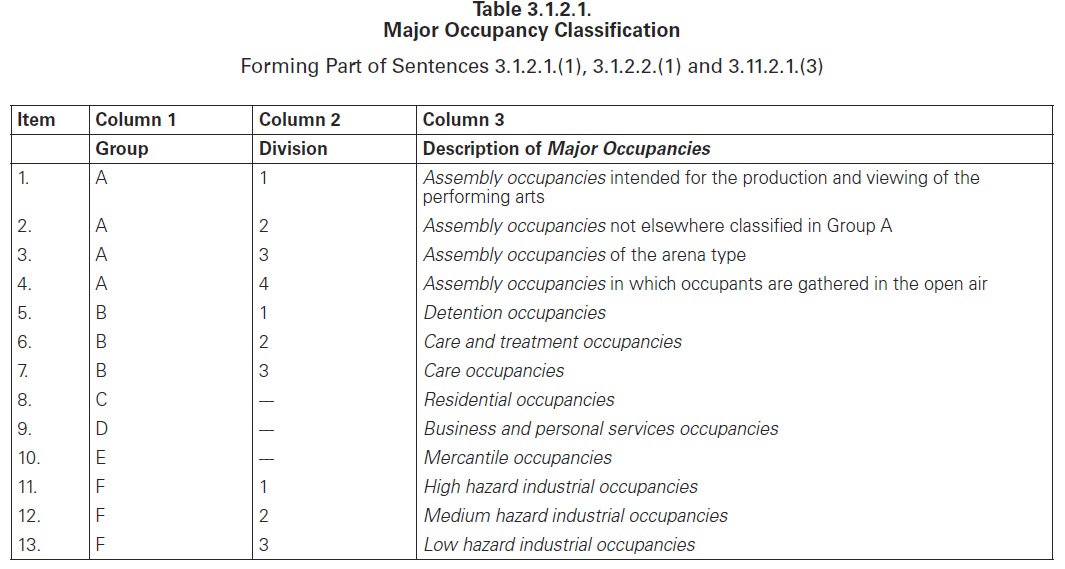.png)
.png)
School of Architectural Technology
Faculty of Applied Science and Technology
ARCH34231 - ARCHITECTURAL STUDIO 6
MODULE 7: ONTARIO BUILDING CODE PART 3 ISSUES
"This module is intended to be nothing more than an introduction. Once you have schematic designs for your projects, you would be in a position to do a Building Code Matrix which will analyze your particular building. Nevertheless, to be forewarned to to be forearmed! This will highlight those parts of the code that might have an impact on your planning phase."
Contents
Note: The 2015 OBC changes are required to be followed, and are far reaching:
Highlights include:
These summares should help:
1. Issues related to Multiple Occupancies
a) Occupancy Choice
Table 3.1.2.1.: Every building or part of a build is to be classified according to its major occupancy as belonging to one of the Groups or Divisions described in Table 3.1.2.1. It is sometimes useful to refer to the appendices of the code for clarification on what the classification is, or of a particular use.
Table 3.1.2.1.

This document may help:
Occupancy Classifications Word document.
b) Major Occupancy Choice
Definitions in 1.4.1.2.: "principal occupancy for which a building or a part of a building is use and is deemed to include the subsidiary occupancies that are an integral part of the principal occupancy."
Just because you have "ancillory spaces" that are also Major Occupancies as described in 3.1.2.1., it does not mean they have shared responsibilities. One occupancy must govern, and that is what you choose.
c) Separations Between Major Occupancies
This table below should be familiar to you by now. The fire separations between adjoining occupancies require Fire-resistance Ratings. Be careful of passageways (doors) or interior screens (windows) you might place in these separations. Percentages of openings requiring "rated closures" are restricted to certain amounts (3.1.8.4 and 3.1.8.6 covers the requirements).
Table 3.1.3.1

d) Openings in Floor Areas
Activities not in the same classification often need to be fire separated from each other. The required ratings are provided in the above Table 3.1.3.1. These relate to walls and separating floors BUT certain floor openings as outlined in 3.2.8. are acceptable. Interconnected Floor Spaces can be done in your work, but they must follow the rules! 3.2.8.3. outlines some of these rules very simply.
Fire Resistance Rating of Floors - Superimposed Major occupancies. (3.2.2.7.)
Superimposed Major Occupancies (except where one is less than 10% of the building area and NOT an F1 nor an F2 occupancy) the FRR (not the fire separation!) required for the floor of the higher occupancy would be based on the 3.2.2. requirements for the lower occupancy.
2. Building Classification under 3.2.2.
a) Streets/ Fire Truck Access
For some classifications (usually combustible construction where not sprinklered) it is important to know from how many directions ("streets") the fire could be fought. Generally speaking, according ot 3.2.2.10., a building is considered to face two streets where not less than 50% of the perimeter is within 15m of a street and three streets where 75% of the perimeter is within 15m of a street. In relation to any of the classifications in 3.2.2., consider your bulding area maximum size depending on how many streets you face.
b) Fire Fighter Access
The requirements for fire truck access, if not a public street right-of-way, are laid out in paragraphs 3.2.5.5. and 3.2.5.6.
c) Definitions
Don't forget the definition of "storey": Definitions in 1.4.1.2. (related to 3.2.1.1.(4)). The space between a floor and the top of the floor above....or if there is no storey above, the ceiling of the floor. A mezzanine level need not be considered a storey provided it meets certain criteria.
Definition of "building area": Definitions in 1.4.1.2. The greatest horizontal area of a building above grade.
d) Classification Choice
Classifications under 3.2.2. where multiple occupancies impact building use include:
Where there is more than one major occupancy the requirements for the most restricted major occupancy must be met. In a building where the aggregate of all major occupancies in a particular Group of Division is more than 10% of the floor area (except for the case of F1 and F2 occupancies).
3. Exit Requirements for an Assembly Occupancy
The following points summarizes those sentences which determine the number and location of exits in an assembly occupancy building.
4. Issues Related to Construction
Heavy timber construction means that type of combustible construction in which a degree of fire safety is attained,
(a) by placing limitations on the sizes of wood structural members and on the thickness and composition of wood floors and roofs, and
(b) by the avoidance of concealed spaces under floors and roofs.
Table 3.1.4.7.

5. Standard OBC 2012 Matrix for Part 3
The "matrix" shown below will be provided to you for your reference, and ultimately your use, below A second matrix which relates to Part 11 and is applicable only to work on existing buildings will be introduced in a later class, and also be provided.
PART 3 MATRIX (January 2014): Word document and PDF document
The Building Departments of most municipalities will require a Building Code Matrix to be submitted along with the permit drawings when an application is being made for a building permit. This is to ensure that someone who has qualifications related to building code issues has ensured that the project meets the requirements of the current OBC.